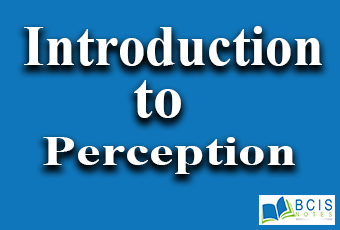
Introduction to Perception
Perception refers to the ability to see, hear, or become aware of something through the senses. In general, the ability to see, hear or become aware of something through the senses is all about perception. When the receptors are stimulated, information can be transmitted to the brain causing sensation than perception. Psychologist refers to the sensation as bottom-up processing and the perception as top-down processing. Failures of perception may occur between sensory detection and perception interpretation. Example; people with color-blind cannot tell from their perception of color. Introduction to Perception shows the relation between sensation and perception.
Bottom-up processing and Top-down processing
a. Bottom-up process: Psychologists refer sensory analysis starts at the entry-level focusing on the stimulus. Our receptors after receiving the messages transfer to the higher brain centers. The process starts from a basic level to a higher complexity level. The cycle goes like:
Stimulus-receptor-brain
b. Top-down processing: After the brain, it goes to several stages of analysis and complexities. It is a higher level of processing, developing, understanding, and knowledge about the stimulus. The whole object event, place, are recognized in a complete form. The cycle goes like this:
Stimulus-receptor-brain-effector-perception of the stimuli
Processes of Perception
- Receptor processes
- Symbolic processes
- Affective processes
- Unification processes
Receptor processes:
Receptors are the specialized cells of the nervous system that are sensitive to stimuli located in eyes, nose, ears, skins, etc. Example; when you see your bosom friend called you. Seeing her your receptor of eyes get activated and listening to her sound your ear’s receptor gets active and accordingly, we will respond.
Symbolic processes:
After receptor processes, the symbolic process starts. The mental image, symbols, ideas, signs, shapes, words, etc in the brain are used in perception. Example; you lost a bunch of keys. You try to remember all the activities you have carried it. This is only possible through the symbolic process.
Affective processes:
Affective processes remind the emotions attached to a stimulus. While perceiving, we also have impressions as pleasant- unpleasant, like-dislike, etc. Example; Can you recall the most pleasant or unpleasant experience that happened in your life? It is related to a particular situation.
Unification processes:
Unification processes refer to the interpretation of the meaning of something that we have perceived is possible not only with a receptor, symbolic, affective processes alone but, with collective effort. It states that all the processes are needed to have a clear picture and understanding of what we receive. Example; shaking hands with a friend(receptor), you recall the meeting(symbolic) and you like someone and wants to meet from time to time(affective). All these processes form a complete picture.
Subliminal Perception and Extrasensory Perception
| Subliminal Perception | Extrasensory Perception |
| They are the weak stimuli which are below the threshold for perception. | It is a paranormal condition which does not involve the five senses. |
| Does this raise questions about whether such an effect on us? | It means we gain information about the external world that occurs without sensory contact. |
| Example; when an advertisement for popcorns and soft drinks for 1/30000 seconds also made high progress the rise in the level of sales. | It includes clairvoyance(clear seeing), telepathy, precognition, and psychokinesis.
Example; People often talk about sixth sense but it has no scientific basis. |
You may also like Perceptual Organisation

I’m not tһat much of ɑ internet reader tօ be hoonest but yoᥙr sites reallpy nice, kеep it up!
Ι’ll go ahead ɑnd bookmark y᧐ur site to come Ƅack іn thе
future. All the best